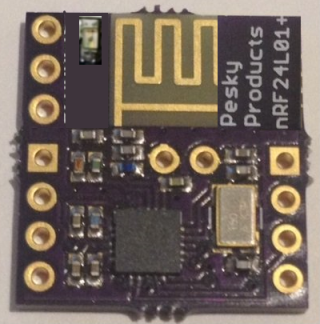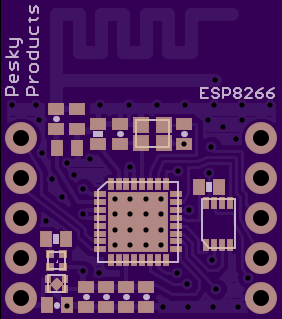defragster
Senior Member+
Not sure if the OP is intrigued by the ESP8266 instead of WixFi250 but the ESP8266 shows lots of movement in the last month - On chip Arduino support as well as full function WiFi with IOT services. Link to Digistump_Erik's OAK project in the works longer than that - hopefully a robust complete solution with good support. Not sure how much of the OAK is doable with ian's design - i.e. what the larger module brings?
Another Blog ... guy getting samples and working with the completed boards too through the growing pains: http://tech.scargill.net/category/esp8266/. Initial boot reset to load code and first xxxIO dev dropped off and another XxxxIO dev tree came out looking better.
Led to other links - PWM notes at the time show it as software powered and dropping when the net gets busy, IDE support at 1.6.2 with 50MB add-on package. And suggested SPI and i2c (master so far) were to be bitbanged at the time - not sure how that will work out but that seems like a job for a LC/3.1 co-processor, I assume OAK has some solution to those as his card shows the pin assignments for them - more to see on that in the next week.
Having a separate Net_WiFi (co)processor to handle that and web (with timeouts and 50% of its cycles burned on networking) not freezing a Teensy - nor counting on it for real time continuity sounds promising - ala onehorse. The Serial hardware and (256B) buffers on the ESP8266 should at least match the Teensy so speed over direct wire might keep that from bogging down Serial coming and going.
onehorse - will you expose the antenna beyond the Teensy? If so the ESP analog or other unique pin(s) 'out there' with a blinky might be a handy supplement - if not as @small.
Another Blog ... guy getting samples and working with the completed boards too through the growing pains: http://tech.scargill.net/category/esp8266/. Initial boot reset to load code and first xxxIO dev dropped off and another XxxxIO dev tree came out looking better.
Led to other links - PWM notes at the time show it as software powered and dropping when the net gets busy, IDE support at 1.6.2 with 50MB add-on package. And suggested SPI and i2c (master so far) were to be bitbanged at the time - not sure how that will work out but that seems like a job for a LC/3.1 co-processor, I assume OAK has some solution to those as his card shows the pin assignments for them - more to see on that in the next week.
Having a separate Net_WiFi (co)processor to handle that and web (with timeouts and 50% of its cycles burned on networking) not freezing a Teensy - nor counting on it for real time continuity sounds promising - ala onehorse. The Serial hardware and (256B) buffers on the ESP8266 should at least match the Teensy so speed over direct wire might keep that from bogging down Serial coming and going.
onehorse - will you expose the antenna beyond the Teensy? If so the ESP analog or other unique pin(s) 'out there' with a blinky might be a handy supplement - if not as @small.




